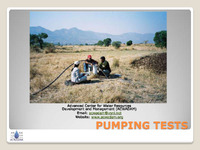Items
Tag
Pumping Tests
-
 Pumping Test methodology Pumping tests are essential procedures used to evaluate how aquifers respond to water extraction from wells. They help well-owners determine their well's yield, the appropriate pump capacity, and aquifer characteristics like Transmissivity and Storativity. The tests involve pumping water from a well, measuring the resulting changes in water levels in both the pumping and nearby observation wells. There are two main types of tests: well tests, focusing on the well's performance, and aquifer performance tests, which assess aquifer properties. Data collected during these tests informs on drawdown, recovery rates, and the aquifer's behavior under varying pumping conditions.
Pumping Test methodology Pumping tests are essential procedures used to evaluate how aquifers respond to water extraction from wells. They help well-owners determine their well's yield, the appropriate pump capacity, and aquifer characteristics like Transmissivity and Storativity. The tests involve pumping water from a well, measuring the resulting changes in water levels in both the pumping and nearby observation wells. There are two main types of tests: well tests, focusing on the well's performance, and aquifer performance tests, which assess aquifer properties. Data collected during these tests informs on drawdown, recovery rates, and the aquifer's behavior under varying pumping conditions. -
 Pumping test analysis The analysis of pumping tests aims to evaluate aquifer properties, specifically Transmissivity (T) and Storativity (S), as well as well characteristics like yield. These tests involve measuring drawdown in pumping and observation wells over time and assessing recovery after pumping stops. Various methods exist for interpreting this data, with graphical techniques such as the Cooper-Jacob method being common. Specific capacity, which indicates a well's ability to yield water, is derived from pump discharge and drawdown measurements. Different approaches are used for bore and dug wells, with Slichter’s method applicable for dug wells to estimate specific capacity based on recovery data.
Pumping test analysis The analysis of pumping tests aims to evaluate aquifer properties, specifically Transmissivity (T) and Storativity (S), as well as well characteristics like yield. These tests involve measuring drawdown in pumping and observation wells over time and assessing recovery after pumping stops. Various methods exist for interpreting this data, with graphical techniques such as the Cooper-Jacob method being common. Specific capacity, which indicates a well's ability to yield water, is derived from pump discharge and drawdown measurements. Different approaches are used for bore and dug wells, with Slichter’s method applicable for dug wells to estimate specific capacity based on recovery data.